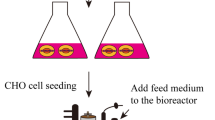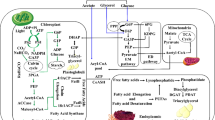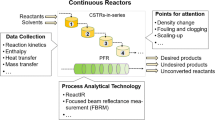Abstract
Suspension animal cell culture is now routinely scaled up to bioreactors on the order of 10,000 L, and greater, to meet commercial demand. However, the concern of the ‘shear sensitivity’ of animal cells still remains, not only within the bioreactor, but also in the downstream processing. As the productivities continue to increase, titer of ~10 g/L are now reported with cell densities greater than 2 × 107 cells/mL. Such high, and potentially higher cell densities will inevitably translate to increased demand in mass transfer and mixing. In addition, achieving productivity gains in both the upstream stage and downstream processes can subject the cells to aggressive environments such as those involving hydrodynamic stresses. The perception of ‘shear sensitivity’ has historically put an arbitrary upper limit on agitation and aeration in bioreactor operation; however, as cell densities and productivities continue to increase, mass transfer requirements can exceed those imposed by these arbitrary low limits. Therefore, a better understanding of how animal cells, used to produce therapeutic products, respond to hydrodynamic forces in both qualitative and quantitative ways will allow an experimentally based, higher, “upper limit” to be created to guide the design and operation of future commercial, large scale bioreactors. With respect to downstream hydrodynamic conditions, situations have already been achieved in which practical limits with respect to hydrodynamic forces have been experienced. This review mainly focuses on publications from both the academy and industry regarding the effect of hydrodynamic forces on industrially relevant animal cells, and not on the actual scale-up of bioreactors. A summary of implications and remaining challenges will also be presented.




Similar content being viewed by others
References
Aloi LE, Cherry RS (1996) Cellular response to agitation characterized by energy dissipation at the impeller tip. Chem Eng Sci 51:1523–1529
Al-Rubeai M, Emery AN, Chalder S, Goldman MH (1993) A flow cytometric study of hydrodynamic damage to mammalian cells. J Biotechnol 31:161–177
Assirelli M, Bujalski W, Eaglesham A, Nienow AW (2008) Macro- and micromixing studies in an unbaffled vessel agitated by a Rushton turbine. Chem Eng Sci 63:35–46
Augenstein DC, Sinskey AJ, Wang DIC (1971) Effect of shear on the death of two strains of mammalian tissue cells. Biotechnol Bioeng 13:409–418
Barbosa MJ, Hadiyanto, Wijffels RH (2004) Overcoming shear stress of microalgae cultures in sparged photobioreactors. Biotechnol Bioeng 85:78–85
Bavarian F, Fan LS, Chalmers JJ (1991) Microscopic visualization of insect cell-bubble interactions I: rising bubbles, air-medium, and the foam layer. Biotechnol Prog 7:140–150
Bluestein M, Mockros LF (1969) Hemolytic effects of energy dissipation in flowing blood. Med Biol Eng 7:1–6
Boulton-Stone JM, Blake JR (1993) Gas bubbles bursting at a free surface. J Fluid Mech 254:103–111
Boychyn M, Doyle W, Bulmer M, More J, Hoare M (2000) Laboratory scaledown of protein purification processes involving fractional precipitation and centrifugal recovery. Biotechnol Bioeng 69:1–10
Boychyn M, Yim SS, Ayazi Shamlou P, Bulmer M, More J, Hoare M (2001) Characterization of flow intensity in continuous centrifuges for the development of laboratory mimics. Chem Eng Sci 56:4759–4770
Boychyn M, Yim SS, Bulmer M, More J, Bracewell DG, Hoare M (2004) Performance prediction of industrial centrifuges using scale-down models. Bioprocess Biosyst Eng 26:385–391
Chattopadhyay D, Rathman J, Chalmers JJ (1995a) The protective effect of specific medium additives with respect to bubble rupture. Biotechnol Bioeng 45:473–480
Chattopadhyay D, Rathman J, Chalmers JJ (1995b) Thermodynamic approach to explain cell adhesion to gas-medium interfaces. Biotechnol Bioeng 48:649–658
Cherry RS, Papoutsakis ET (1986) Hydrodynamic effects on cells in agitated tissue culture reactors. Bioprocess Eng 1:81–89
Cherry RS, Papoutsakis ET (1988) Physical mechanisms of cell damage in microcarrier bioreactors. Biotechnol Bioeng 32:1001–1014
Cherry RS, Papoutsakis ET (1989) Hydrodynamic effects on cells in agitated tissue culture reactors. Bioprocess Eng 1:29–41
Chisti Y (2000) Animal-cell damage in sparged bioreactors. TIBTECH 18:420–432
Clay JD, Koelling KW (1997) Molecular degradation of concentrated polystyrene solutions in a fast transient extensional flow. Polym Eng Sci 37:789–800
Crespi CL, Thilly WG (1981) Continuous cell propagation using low-charge microcarriers. Biotechnol Bioeng 3:983–993
Costes J, Couderc JP (1988) Influence of the size of units - II spectral analysis and scales of turbulence. Chem Eng Sci 43:2765–2772
Croughan MS, Hamel JF, Wang DIC (1987) Hydrodynamic effect on animal cells grown in microcarrier cultures. Biotechnol Bioeng 29:130–141
Croughan MS, Sayre ES, Wang DIC (1989) Viscous reduction of turbulent damage in animal cell cultures. Biotechnol Bioeng 33:862–872
Cutter LA (1966) Flow and turbulence in a stirred tank. AICHE J 12:35–40
Fan LS, Tsuchiya K (1990) Bubble wake dynamics in liquids and liquid–solid suspensions. Butterworth Heinemann, Boston
Garcia-Briones MA, Chalmers JJ (1994) Flow parameters associated with hydrodynamic cell injury. Biotechnol Bioeng 44:1089–1098
Garcia-Briones M, Brodkey R, Chalmers J (1994) Computer simulations of the rupture of a gas bubble at a gas-liquid interface and its implications in animal cell damage. Chem Eng Sci 49:2301–2320
Gigout A, Buschmann MD, Jolicoeur M (2008) The fate of pluronic F-68 in chondrocytes and CHO cells. Biotechnol Bioeng 100:975–987
Godoy-Silva R, Mollet M, Chalmers JJ (2009a) Evaluation of the effect of chronic hydrodynamic stresses on cultures of suspended CHO-6E6 cells. Biotechnol Bioeng 102:1119–1130
Godoy-Silva R, Chalmers JJ, Casnocha SA, Bass LA, Ma N (2009b) Physiological response of CHO cells to repetivtive hydrodynamic stress. Biotechnol Bioeng 103:1103–1117
Godoy-Silva R, Berdogo C, Chalmers JJ (2010) Aeration, mixing, and hydrodynamics in bioreactors. In: Flickinger M (ed) The encyclopedia of industrial biotechnology: bioprocess, bioseparation, and cell technology. Wiley, New York
Gregoriades N, Clay J, Ma N, Koelling K, Chalmers JJ (2000) Cell damage of microcarrier cultures as a function of local energy dissipation created by a rapid extensional flow. Biotechnol Bioeng 69:171–182
Hirtenstein MD, Clark JM (1980) Critical parameters in the microcarrier cultures of animal cells. Dev Biol Stand 46:117–124
Hoh JH, Schoenenberger CA (1994) Surface morphology and mechanical properties of MDCK monolayers by atomic force microscopy. J Cell Sci 107:1105–1114
Hu W, Rathman JJ, Chalmers JJ (2008) An investigation of small-molecule surfactants to potentially replace pluronic F-68 for reducing bubble-associated cell damage. Biotechnol Bioeng 101:119–127
Huang YM, Hu W, Rustandi E, Shen V, Yusuf-Makagiansar H, Ryll T (2010) Maximizing productivity of CHO cell based fed-batch culture using chemically defined media conditions and typical manufacturing equipment. Biotechnol Prog 26:1400–1410
Hutchinson N, Bingham N, Murrell N, Farid S, Hoare M (2006) Shear stress analysis of mammalian cell suspensions for prediction of industrial centrifugation and its verification. Biotechnol Bioeng 95:483–491
Joosten CE, Shuler ML (2003) Effect of culture conditions on the degree of sialylation of a recombinant glycoprotein expressed in insect cells. Biotechnol Prog 19:739–749
Joshi JB, Elias CB, Patole MS (1996) Role of hydrodynamic shear in the cultivation of animal, plant and microbial cells. Chem Eng Sci 62:121–141
Kao YH, Hewitt DP, Terxler-Schmidt M, Laird MW (2010) Mechanism of antibody reduction in cell culture production processes. Biotechnol Bioeng 107(4):622–632
Katinger HWD, Scheirer W, Kromer E (1979) Bubble column reactor for mass propagation of animal cells in suspension culture. Ger Chem Eng 2:31–38
Keane JT, Ryan D, Gray PP (2003) Effect of shear stress on expression of a recombinant protein by Chinese hamster ovary cells. Biotechnol Bioeng 81:211–220
Kioukia N, Nienow AW, Al-Rubeai M, Emery AN (1992) The impact of fluid dynamics on the biological performance of free suspension animal cell culture: further studies. Food Bioprod Proc (Tans I Chem E, Part C) 70:143–148
Kioukia N, Nienow AW, Al-Rubeai M, Emery AN (1996) Influnce of agitation and sparging on the growth rate and infection of insect cells in bioreactors and a comparison with hybridoma culture. Biotechnol Prog 12:779–785
Kresta S (1998) Turbulence in stirred tanks: anisotropic, approximate, and applied. Can J Chem Eng 76:563–576
Kunas KT, Papoutsakis ET (1990) Damage mechanisms of suspended animal cells in agitated bioreactors with and without bubble entrainment. Biotechnol Bioeng 36:476–483
Langheinrich C, Nienow AW (1999) Control of pH in large scale, free suspension animal cell bioreactors: alkali addition and pH excursions. Biotechnol Bioeng 66:171–179
Levy MS, Collins SS, Yim SS, Ward JM, Titchener-Hooker N, Shamlou PA, Dunnill P (1999a) Effect of shear on plasmid DNA solution. Bioprocess Eng 20:7–13
Levy MS, Ciccolini LAS, Yim SSS, Tsai JT, Titchener-Hooker N, Ayazi Shamlou P, Dunnill P (1999b) The effects of material properties and fluid flow intensity on plasmid DNA recovery during cell lysis. Chem Eng Sci 54:3171–3178
Li YSJ, Haga JH, Chien S (2005) Molecular basis of the effects of shear stress on vascular endothelial cells. J Biomech 38:1949–1971
Li F, Hashimura Y, Pendleton R, Harms J, Collins E, Lee B (2006) A system approach for scale-down model development and characterization of commercial cell culture processes. Biotechnol Prog 22:696–703
Luan YT, Wang W, Nolan R, Drapeau D (2006) Defined medium development for high yielding mammalian cell culture processes. In: IBC & bioprocess international conference, Nov 2006, San Francisco, CA
Ma N, Koelling KW, Chalmers JJ (2002) Fabrication and use of a transient contractional flow device to quantify the sensitivity of mammalian and insect cells to hydrodynamic forces. Biotechnol Bioeng 80:428–437
Ma N, Chalmers JJ, Aunins JG, Zhou W, Xie L (2004) Quantitative studies of cell-bubble interactions and cell damage at different Pluronic F-68 and cell concentrations. Biotechnol Prog 20:1183–1191
MacIntyre F (1972) Flow patterns in breaking bubbles. J Fluid Mech 77:5211–5228
Markopoulos J, Kontogeorgaki E (1995) Vortex depth in unbaffled single and multiple impeller agitated vessels. Chem Eng Technol 18:68–74
McCoy R, Hoare M (2009) Ultra scale-down studies of the effect of shear on cell quality: processing of human cell line for cancer vaccine therapy. Biotechnol Prog 25:1448–1458
McCoy R, Ward S, Hoare M (2010) Sub-population analysis of human cancer vaccine cells—ultra scale-down characterization of response to shear. Biotechnol Bioeng 106:584–595
McDowell CL, Papoutsakis ET (1998) Increased agitation intensity increases CD13 receptor surface content and mRNA levels, and alters the metabolism of HL60 cells cultured in a stirred tank bioreactor. Biotechnol Bioeng 60:239–250
McQueen A, Bailey JE (1989) Influence of serum level, cell line, flow type and viscosity on flow-induced lysis of suspended mammalian cells. Biotechnol Lett 11:531–536
Meier SJ, Hatton TA, Wang DIC (1999) Cell death from bursting bubbles: role of cell attachment to rising bubbles in sparged reactors. Biotechnol Bioeng 62:468–478
Michaels JD, Papoutsakis ET (1991) Polyvinyl alcohol and polyethylene glycol as protectants against fluid-mechanical injury of freely-suspended animal cells (CRL8018). J Biotechnol 19:241–258
Michaels JD, Kunas KT, Papoutsakis ET (1992) Fluid-mechanical damage of freely-suspended animal cells in agitated bioreactors: effects of dextran, derivatized celluloses and polyvinyl alcohol. Chem Eng Commun 118:341–360
Michaels J, Nowak JE, Mallik AK, Koczo K, Wasan DT, Papoutsakis ET (1995) Analysis of cell-to-bubble attachment in sparged bioreactors in the presence of cell-protecting additives. Biotechnol Bioeng 47:407–419
Mollet M, Ma N, Zhao Y, Brodkey R, Taticek R, Chalmers JJ (2004) Bioprocess equipment: characterization of energy dissipation rate and its potential to damage cells. Biotechnol Prog 20:1437–1448
Mollet M, Godoy-Silva R, Berdugo C, Chalmers JJ (2007) Acute hydrodynamic forces and apoptosis: a complex question. Biotechnol Bioeng 98:772–788
Mollet M, Godoy-Silva R, Berdugo C, Chalmers JJ (2008) Computer simulations of the energy dissipation rate in a fluorescence activated cell sorter: implications to cells. Biotechnol Bioeng 100:260–272
Mostafa SS, Gu X (2003) Strategies for improved dCO2 removal in large-scale fed-batch cultures. Biotechnol Prog 19:45–51
Motobu M, Wang P-C, Matsumura M (1998) Effect of shear stress on recombinant Chinese hamster ovary cells. J Ferment Bioeng 85:190–195
Murhammer DW, Goochee CF (1990) Structural features of nonionic polyglycol polymer molecules responsible for the protective effect in sparged animal cell bioreactors. Biotechnol Prog 6:142–148
Neal G, Christie J, Keshavarz-Moore E, Shamlou PA. (2003) Ultra scale-down approach for the prediction of full-scale recovery of ovine polycholonal immunoglobulins used in the manufacture of snake vemon-specific Fab fragment. Biotechnol Bioeng 81(2):149–157
Niagam P (2006) Interaction of water-soluble surfactants with self-assembled lipid monolayers at the vapor-liquid interface: equilibrium and dynamic phenomena. PhD thesis. The Ohio State University
Nienow AW (2006) Reactor engineering in large scale animal cell culture. Cytotechnology 50:9–33
Okamoto Y, Nishikawa M, Hashimoto K (1981) Energy Dissipation Rate Distribution in Mixing Vessels and Soild-Liquid Mass Transfer. Int Chem Eng 21:88–94
Oh SKW, Nienow AW, Al-Rubeai M, Emery AN (1989) The effects of agitation intensity with and without continuous sparging on the growth and antibody production of hybridoma cells. J Biotechnol 12:45–62
Oh SKW, Nienow AW, Al-Rubeai M, Emery AN (1992) Further studies of the culture of mouse hybridomas in an agitated bioreactor with and without continuous sparging. J Biotechnol 22:245–270
Palomares LA, González M, Ramírez OT (2000) Evidence of Pluronic F-68 direct interaction with insect cells: impact on shear protection, recombinant protein, and baculovirus production. Enzym Microb Technol 26:324–331
Ramirez OT, Mutharasan R (1990) The role of the plasma membrane fluidity on the shear sensitivity of hybridoma growth under hydrodynamic stress. Biotechnol Bioeng 36:911–920
Ranjan V, Waterbury R, Xiao Z, Diamond SL (1995) Fluid shear stress induction of the transcriptional activator c-fos in human and bovine endothelial cells, Hela, and Chinese hamster ovary cells. Biotechnol Bioeng 49:383–390
Senger R, Karim MN (2003) Effect of shear stress on intrinsic CHO culture state and glycosylation of recombinant tissue-type plasminogen activator protein. Biotechnol Prog 19:1199–1209
Swim HE, Parker RF (1960) Effect of Pluronic F68 on growth of fibroblasts in suspension on rotary shaker. Proc Soc Exp Biol Med 103:252–254
Tatterson GB, Yuan HS, Brodkey BS (1980) Stereoscopic visualization of the flows for pitched blade turbines. Chem Eng Sci 35:1369–1375
Telling RC, Elsworth R (1965) Submerged culture of hamster kidney cells in a stainless steel vessel. Biotechnol Bioeng 7:417–434
Thomas CR, Al-Rubeai M, Zhang Z (1994) Prediction of mechanical damage to animal cells in turbulence. Cytotechnol 15:329–335
Trexler-Schmidt M, Sargis S, Chiu J, Sze-Khoo S, Mun M, Kao YH, Laird MW (2010) Identification and prevention of antibody disulfide bond reduction during cell culture manufacturing. Biotechnol Bioeng 106:452–461
Trinh K, Garcia-Briones M, Hink F, Chalmers JJ (1994) Quantification of damage to suspended insect cells as a result of bubble rupture. Biotechnol Bioeng 43:37–45
Vakili MH, Esfahanny MN (2009) CFD analysis of turbulence in a baffled stirred tank, a three-compartment model. Chem Eng Sci 64:351–362
Van der Pol LA, Beeksma I, Tramper J (1995) Polyethylene glycol as protectant against damage caused by sparging for hybridoma suspension cells in a bubble column. Enzym Microb Technol 17:401–407
Van’t Riet K, Smith JM (1975) The trailing vortex system produced by Rushton turbine agitators. Chem Eng Sci 30:1093–1105
Varley J, Birth J (1999) Reactor design for large scale suspension animal cell culture. Cytotechnology 29:177–205
Venkat R, Stock R, Chalmers JJ (1996) Study of hydrodynamics in microcarrier culture spinner vessels: a particle tracking velocimetry approach. Biotechnol Bioeng 49:456–466
Vickroy B, Lorenz K, Kelly W (2007) Modeling shear damage to suspended CHO cells during cross-flow filtration. Biotechnol Prog 23:194–199
Wernersson ES, Trägårdh C (1999) Scale-up of Rushton turbine-agitated tanks. Chem Eng Sci 54:4245–4256
Westoby M, Rogers JK, Haverstock R, Romero J, Pieracci J (2011) Modeling industrial centrifugation of mammalian cell culture using a capillary based scale-down system. Biotechnol Bioeng 108:989–998
Wu H, Patterson GK (1989) Laser-Doppler measurements of turbulent flow parameters in a stirred mixer. Chem Eng Sci 44:2207–2221
Wurm FM (2004) Production of recombinant protein therapeutics in cultivated ammalian cells. Nat Biotechnol 22:1393–1398
Xing Z, Kenty BM, Li ZJ, Lee SS (2009) Scale-up analysis for a CHO cell culture process in large-scale bioreactors. Biotechnol Bioeng 103:733–746
Zhang Z, Thomas CR (1993) Modeling of animal cell damage in turbulent flows. In: Nienow AW (eds) Proc. 3rd int. conf. on bioreactor and bioprocesses fluid dynamics. Mechanical Engineering Publications Ltd., London, pp 475–482. ISBN 0852988737
Zhang Z, Ferenczi MA, Thomas CR (1992) A micromanipulation technique with theoretical cell model for determining mechanical properties of single mammalian cells. Chem Eng Sci 47:1347–1354
Zhou G, Kresta SM (1996a) Distribution of energy dissipation between convective and turbulent flow for three frequently used impellers. Trans I Chem E 74:379–389
Zhou G, Kresta SM (1996b) Impact of tank geometry on the maximum turbulence energy dissipation rate for impellers. AIChE J 42:2476–2490
Zhu MM, Goyal A, Rank DL, Gupta SK, VandenBoom T, Lee SS (2005) Effects of elevated pCO2 and osmolality on growth of CHO cells and production of antibody-fusion protein B1: a case study. Biotechnol Prog 21:70–77
Zhu Y, Cuenca JV, Zhou W, Varma A (2008) NS0 cell damage by high gas velocity sparging in protein-free and cholesterol-free cultures. Biotechnol Bioeng 101:751–760
Author information
Authors and Affiliations
Corresponding author
Rights and permissions
About this article
Cite this article
Hu, W., Berdugo, C. & Chalmers, J.J. The potential of hydrodynamic damage to animal cells of industrial relevance: current understanding. Cytotechnology 63, 445–460 (2011). https://doi.org/10.1007/s10616-011-9368-3
Received:
Accepted:
Published:
Issue Date:
DOI: https://doi.org/10.1007/s10616-011-9368-3




